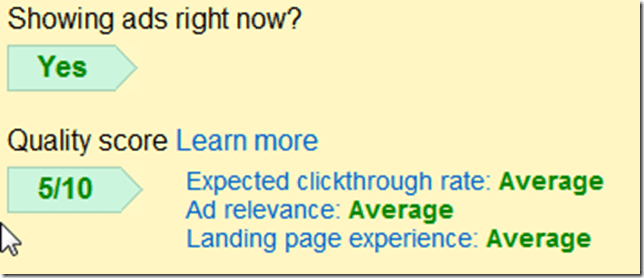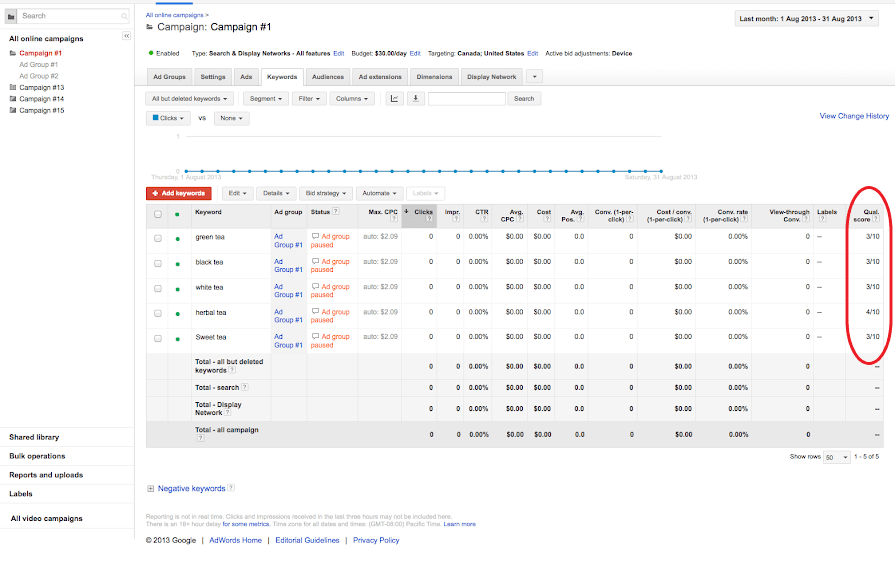As an advertiser, one of your top goals is reaching your target audience with relevant, high-quality ads that result in more engagement, clicks, and conversions. Well, improving your Google Ads Quality Score will help you do just that.
Google assigns each of your keywords a quality score, which lets you know how well your ads match your keywords.
But your Google Ads Quality Score does much more than that: It also influences your paid search campaigns’ cost and performance.
Given the importance of your Google Ads Quality Score, this guide will tell you everything you need to know about the metric, including how to increase your score—which will lead to better Google Ads positioning and lower costs.
What Is Your Google Ads Quality Score?
Simply put, the quality score is how Google rates the quality and relevance of your keywords and pay-per-click (PPC) ads. Each keyword gets a quality score that reflects how appealing Google thinks your ads are to people searching for that keyword. The score is from 1 to 10, where 1 is a bad match, and 10 is a great fit.
Google considers three main factors when calculating your quality score:
- Expected click-through rate (CTR)
- Relevance to search intent
- Landing page user experience
While only Google knows exactly how much influence each component has on their quality score algorithm, CTR is likely the most important factor. The more people who click your ad after viewing it, the more relevant and useful the ad seems in Google’s eyes.
Ad quality is an important factor during Google’s ad auction process, where your ad rank and cost-per-click (CPC) are determined. But it’s important to note that Google doesn’t simply apply your numerical Google Ads Quality Score during the auction. Instead, your score is just a reflection of the quality of your ad.
Google uses an array of different factors (such as the exact search term of a user and their location and device type) to assess the quality of your ads in real-time during an auction. It then gives you your Google Ads Quality Score as a summary of that assessment. Essentially, the score serves as a health metric to let you know how your ads are doing.
Why Work to Raise Your Google Ads Quality Score?
Even though the numbered score itself isn’t used at auction time, your Google Ads Quality Score is tied to your PPC success. The higher your score, the better quality Google thinks your ad is. Higher-quality ads perform better at ad auctions and have top rankings.
That means that if you improve your score, Google will likely reward you with a higher ad ranking, leading to more—and better—ad placements.
As an added benefit, your CPC will decrease as your ad quality improves. Google sets ad rank thresholds, which are minimum costs that your ad has to hit before it’s shown to customers. Higher-quality ads have lower ad rank thresholds and, therefore, lower CPCs. This translates to more impressions (and hopefully more ad clicks) at a lower cost.
In addition, higher Google Ads Quality Scores mean lower costs per conversion. Ultimately, that has more value than click costs because it relates to how much you pay when people take an action in response to your ad—whether you’re trying to get Google users to purchase a product or download an app.
By optimizing your Google Ads Quality Score, you’ll be well on your way to a higher return on investment (ROI) on your ad spend.
Google Ads Quality Score Levels
Though Google only assigns one quality score per keyword, you might have multiple keywords for an ad or ad group. This means you could have several different quality scores within each ad group. When you’re evaluating your ad’s overall quality, there are two levels of quality score you can check: keyword level and ad group level.
Keyword-Level Score
For every ad quality score, Google assigns a rating of 1 through 10 for the ad’s keyword.

NOTE: Your score will track historical keyword performance on Google.com until your keywords reach a certain threshold of impressions (in the thousands). It won’t be until after your account reaches that point that your keyword quality score will start reflecting your actual performance.
Once you’ve passed the impression threshold, you’ll see a breakdown of the factors Google uses to calculate your quality score, including your ad’s current and historic data for CTR, relevance, and landing page experience.
Check each factor as well as your overall quality score. If relevance or CTR scores are low, it shows that users don’t find your ad relevant to their search queries. Adjust your ads to make sure they fit your chosen keywords.
Ad Group-Level Score
The ad group score is an average of the quality scores assigned to each of the keywords in a given ad group.
The ad group score can help you see where you need to make adjustments. For example, say your ad group has five target keywords. The score for one keyword is 3, but the overall ad group score is 7. You now know you need to adjust your ads to match the low-performing keyword more closely or take the keyword out because it’s not as relevant to user interest as your other keywords.
Improving your lowest average ad group-level score first helps gives you a better ROI. You craft your ads to be as relevant as possible for your audience so you get the most value out of your ad spend.
4 Ways to Raise Your Google Ads Quality Score
The higher your quality score, the better your Google Ads are doing overall. Here are a few ways to boost your score and encourage strong ad performance.
1. Improve Your Mobile Performance
Google includes performance across devices in your quality score, so optimizing your ads and landing pages for mobile will boost your score overall.
When creating the ad, use mobile-friendly extensions to improve the ad experience for people using smartphones or tablets. For example, adding a click-to-text extension makes it easy for users to contact you on mobile: They just click “Send Us a Text” to quickly send a message.
Google says that mobile loading speed directly affects quality score, so work to increase the speed of your website and landing pages. You can test your site’s mobile loading speed with this free tool from Google.2. Create Single-Keyword Ad Groups
The best way to improve your Google Ads Quality Score is to make your ads as relevant as possible to people searching for your keywords. Creating single-keyword ad groups (SKAGs) makes it easier to keep your ads focused so that they closely match search intent.
SKAGs also help prevent needless ad spend. When you pay per click, you want to ensure your clicks come from genuinely interested parties so that you can maximize the conversion rate. If your ads and landing pages match search intent, then people who click on your ad are getting what they expect—and are more likely to convert.
3. Use A/B Testing
Another way to improve relevance and CTR is by testing ad copy and creative to see what resonates best with your audience. Try different calls to action (CTAs) to see what attracts more clicks.
If you’re running ads on the Google Display Network, Google will show your ads on various sites to potential and current customers. Try different ad formats, images, and copy to see what ads perform best across the board. Use tools like Google Ads suggestions to get ideas.
The more tests you run, the better you can fine-tune your campaigns and improve your CTR.
4. Optimize Your Landing Page
Landing page experience is one of the three factors used to calculate your Google Ads Quality Score. You can raise your score by optimizing your landing pages for your target keywords and checking them for loading speed, reliability, and other elements that affect user experience.

- Relevance and originality of content
- Transparency
- Navigability
The reason is that the tech giant wants advertisers to create quality websites that Google users will find both relevant and useful.
But the fact is, landing page quality should be a priority for you anyway. Why? Because quality landing pages are more likely to convert visitors into customers.
A high-quality landing page needs to be:
-
Ad relevant:
Whether you have a single landing page for all campaigns or a custom one for each ad, your landing pages must be clearly related to the ads they correspond with. If your ad is for baby socks, link to a page featuring baby socks rather than your home page or a general clothing page.
-
Fast loading:
In today’s digital world, page loading speed can make the difference between a sale and a bounce. Your landing page should load quickly (in under three seconds), or it will negatively affect not only your SEO but your Google Ads Quality Score as well.
-
Easy to navigate:
Your landing page should have clear, easy-to-use navigation that makes it simple for visitors to find information and get in touch with you.
-
Indexable:
If Google robots can’t successfully crawl your landing page, they won’t be able to determine how relevant it is, and your quality score will take a hit.
When crafting your ad campaigns, make sure your landing pages cover all the bases.
Boost Ad Performance with Your Google Ads Quality Score
Your quality score is an important health metric for your ads.
It can show you where you need to make changes, and how to improve your ads so they’re as relevant as possible for your target audience.
Use the above tactics to steadily boost your quality score, increasing your ads’ exposure and significantly lowering campaign cost in the process.




great article about Google quality scores. you have explained in detail about the different ways how we can actually improve the quality scores. but in Google display campaigns is there a way to practically check the quality scores of the keywords?
Awesome Article
On google quality score. I totally agree with this article’s content.
Thank you for sharing your great knowledge with us.
Looking forward to your further tips on similar topics Thanks… I really appreciate it.
I am very thankful to you as your article has given me lots of ideas. I enjoyed a lot by reading this post. Thanks for sharing your blog. – it staffing company in hyderabad
Very helpful post about quality score, It can help us to boost our ads performance by boosting quality score. Thank you very much!